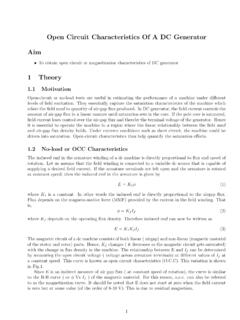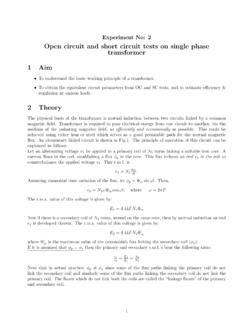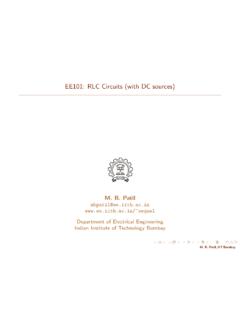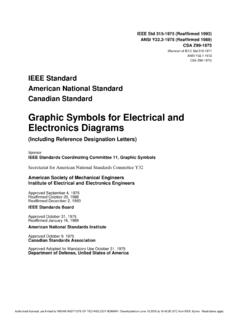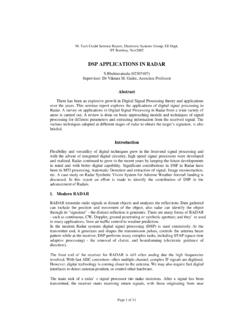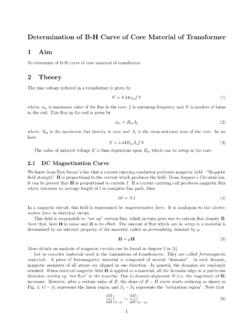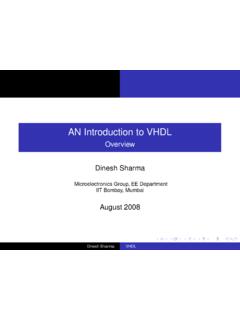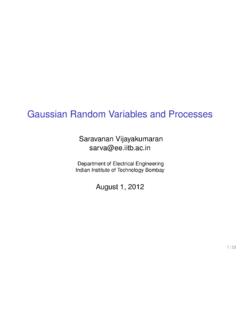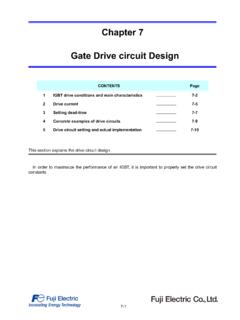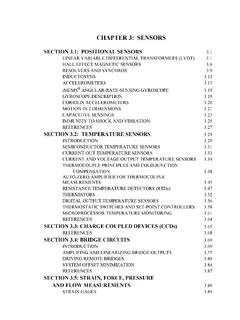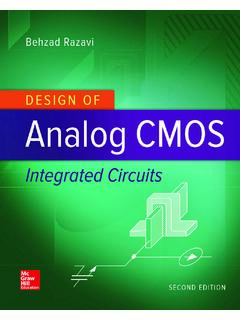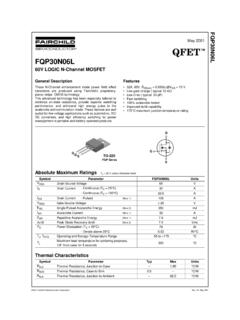Transcription of MOSFET Characteristics- Theory and Practice
1 Basics of the MOSFETThe MOSFET OperationThe ExperimentMOSFET characteristics - Theory and PracticeDebapratim Systems GroupDepartment of Electrical EngineeringIndian Institute of Technology Bombay20 September 2012 Debapratim GhoshDept. of EE, IIT Bombay1/20 Basics of the MOSFETThe MOSFET OperationThe ExperimentMOS StructureMOS Structure OperationIntroduction- the MOSFETM etalOxideSemiconductorFieldEffectTransis torThe name describes nearly everything about the device first three wordsMetalOxideSemiconductor describes the layer-wisestructure of the last three wordsFieldEffectTransistor describes the principle GhoshDept.
2 Of EE, IIT Bombay2/20 Basics of the MOSFETThe MOSFET OperationThe ExperimentMOS StructureMOS Structure OperationMOS Structure PhysicsMOS transistors can be of two types- NMOS and NMOS has a lightly doped p-substrate (where there is scarcity ofelectrons).The metal terminal is called the oxide layer (usually SiO2) is an p-type substrate is grounded while the gate voltageVGis will see how the MOS structure behaves asVGis GhoshDept. of EE, IIT Bombay3/20 Basics of the MOSFETThe MOSFET OperationThe ExperimentMOS StructureMOS Structure OperationMOS Structure Physics- AccumulationLet us apply a negative gate voltage < negativeVGsets up an electric field through the electrons (minority carriers) are pushed away towards ground, and theholes (majority carriers) are pushed towards the region below the oxide is now devoid of n-type charge region of operation is calledaccumulation +++++++++++++++E-fieldVG<0 Debapratim GhoshDept.
3 Of EE, IIT Bombay4/20 Basics of the MOSFETThe MOSFET OperationThe ExperimentMOS StructureMOS Structure OperationMOS Structure Physics- DepletionLet us apply a small positive gate smallVGsets up a weak electric field though the holes are now pushed away from the oxide, deep into the , the electric field is too weak to pull all the minority electronstowards the this time, the immediate region below the oxide is devoid of any mobilecharges (electrons or holes).This region of operation is calleddepletion E-fieldVG= 0+Accumulated carriersRegion devoid of carriersDebapratim GhoshDept.
4 Of EE, IIT Bombay5/20 Basics of the MOSFETThe MOSFET OperationThe ExperimentMOS StructureMOS Structure OperationMOS Structure Physics- InversionLet us now increase the gate , the electric field becomes stronger, and the minorityelectrons accumulate below the a certain value ofVG, the concentration of moblie electrons becomes sohigh that the region just below the oxide becomes as n-type as the rest of thesubstrate is region of operation is calledinversion accumulated electrons can now be used to generate a 0 Debapratim GhoshDept. of EE, IIT Bombay6/20 Basics of the MOSFETThe MOSFET OperationThe ExperimentMOS StructureMOS Structure OperationMOS Threshold VoltageTo accumulate mobile electrons below the oxide, the gate voltage VG has to besufficiently high to cross the threshold.
5 This is governed by a number of work-function difference between the gate and the siliconsubstrate (thisleads to the flatband voltage).The gate voltage component required to bring about surface inversion(surface just below the oxide).The concentration of acceptor ions in the concentration of trapped charges inside the substrate voltage (so far weve assumed it to be ground).Note:The threshold voltageVTNfor NMOS is threshold voltageVTPfor PMOS is GhoshDept. of EE, IIT Bombay7/20 Basics of the MOSFETThe MOSFET OperationThe ExperimentThe MOS TransistorOperating Regions of the MOSFETThe MOS TransistorOnce the threshold has been crossed, we need to make the electrons move, set up a this, we need two more terminals- Source (S) and Drain (D), and apotential across them to control the flow of drain and source are heavily-doped n-type now have a 4-terminal device- drain, source, gate and drain and source can be interchanged!
6 Source (S)Gate (G)Drain (D)Body (B)p-substraten+n+Debapratim GhoshDept. of EE, IIT Bombay8/20 Basics of the MOSFETThe MOSFET OperationThe ExperimentThe MOS TransistorOperating Regions of the MOSFETMOS Transistor characteristics - Linear RegionAssume thatVG>VTNandVGS VTN> device is on as the threshold has been crossed. The inversion layer (fullof electrons) is now a connecting path between the two n+-type source anddrain to a nonzeroVDS, electrons flow from the drain to the source via theinversion layer. The inversion layer is now called a current flowing in the channel is called the drain current (ID).
7 For thisbias condition,IDis given byID=kn2(2(VGS VTN)VDS V2DS)(1)VS= 0 VGVDn+channeln+n+Debapratim GhoshDept. of EE, IIT Bombay9/20 Basics of the MOSFETThe MOSFET OperationThe ExperimentThe MOS TransistorOperating Regions of the MOSFETMOS Transistor characteristics - Linear Region (cont )Based on our discussion so far, try to do the following the above biasing, plot a graph ofIDv/sVGSas you increaseVGS,starting from 0V. You may assume thatVDSis small (though not necessary).Now you know why this is called thelinearregion!Now for a givenVGS, plot a graph ofIDv/sVDSas you increaseVDS,starting from 0V.
8 At what value ofVDSis theIDmaximum?Debapratim GhoshDept. of EE, IIT Bombay10/20 Basics of the MOSFETThe MOSFET OperationThe ExperimentThe MOS TransistorOperating Regions of the MOSFETMOS Transistor characteristics - Saturation RegionWe have seen that theIDreaches a maxima whenVDS=VGS this time, we see that theVGD=VTN. At this time, the channel depth at thedrain-substrate interface is zero. This is called increased further,VGD<VTNand the pinchoff point shifts towardsthe now very weakly dependent onVDS. The channel voltage is equal toVDS,sat=VGS VTN. The rest of the drain bias voltage is across the VTNin equation (1), we getID=kn2(VGS VTN)2(2)VS= 0 VGVDn+n+Debapratim GhoshDept.
9 Of EE, IIT Bombay11/20 Basics of the MOSFETThe MOSFET OperationThe ExperimentThe MOS TransistorOperating Regions of the MOSFETThe Saturation Region (cont )From equation (2) we see thatIDis now independent plot ofIDv/sVDSin the saturation region is a straight line parallel tothe VDS does not happen practically. If the effective length after pinch-off, , is significantly less,IDdoes change withVDS!We know that,kn= nCox(WL). After pinch-off, we havekn= nCox(WL ).AssumeL =L L. Substitute this in (2).VS= 0 VGVDL Ln+n+Debapratim GhoshDept. of EE, IIT Bombay12/20 Basics of the MOSFETThe MOSFET OperationThe ExperimentThe MOS TransistorOperating Regions of the MOSFETThe Saturation Region (cont )We now haveID=(11 LL) nCox2(WL)(VGS VTN)2(3)It can also be shown that, L VDS VDS,sat.
10 Using power series, we get1 LL= 1 VDSA ssuming VDS 1, equation (3) now becomesID= nCox2(WL)(VGS VTN)2(1 + VDS)(4)Clearly, the decrease in channel length causesIDto be linearly varying withVDS!This is calledchannel length modulation, and is a critical issue in IC GhoshDept. of EE, IIT Bombay13/20 Basics of the MOSFETThe MOSFET OperationThe ExperimentThe MOS TransistorOperating Regions of the MOSFETBJT and MOSFET - A ComparisonBipolar Junction TransistorMOS Transistor1. Current-controlled current source 1. Voltage-controlled current source2. Current flows due to both electronsand holes (bipolar)2.
